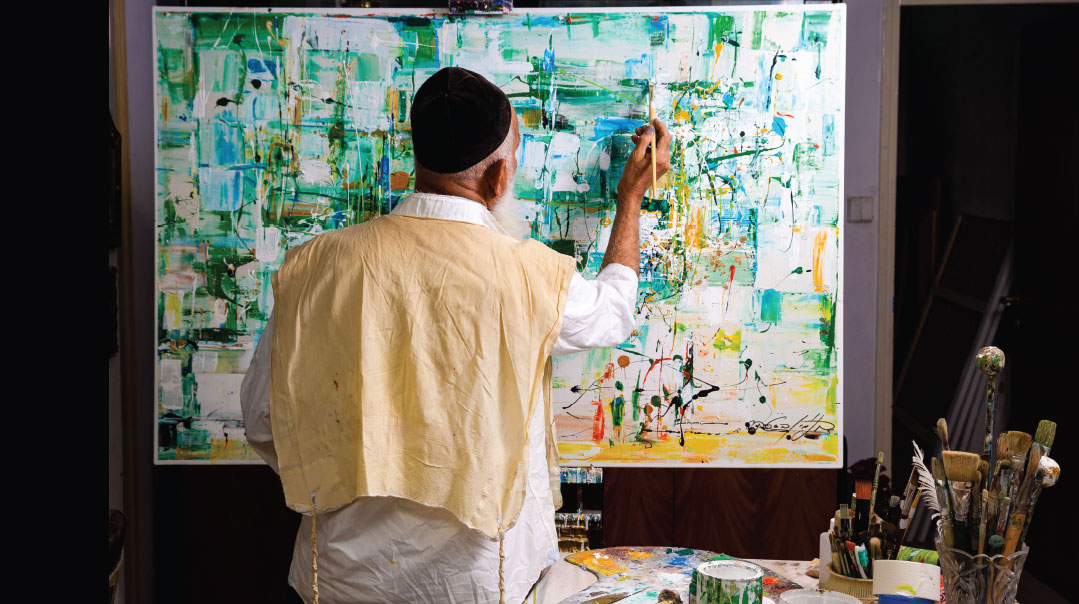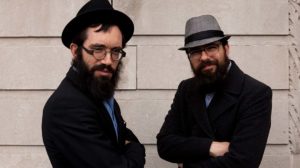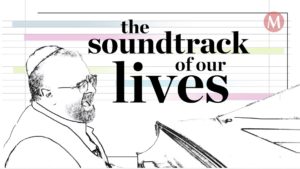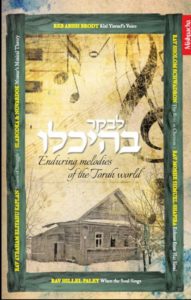The Big Picture

Mumbai native Binyamin Basteker's entire life is about extracting surprises from a blank canvas and following his soul instead of the trends

Photos: Elchanan Kotler
W
e’re all familiar with the echoes of the Holy City and each of us relates to those sounds in a different way: the murmurings of prayer at the Kosel, the honking cabs dodging pedestrians on Malchei Yisrael Street, the voices of Torah wafting from the windows of small and big yeshivos, the siren ushering in Shabbos. These are the melodies that play in our heart and soul, but can we really give them expression?
Jerusalem artist Binyamin Basteker can, and in his exhibition titled “Sounds of Jerusalem,” he proves himself a master of transforming rhythm to color, sounds to strokes. A painting of the Kosel is not really a painting of the Kosel. A landscape is really a dream. The ancient Splitting of the Sea transforms into a uniquely personal and present moment.
“I see spirituality in so many places that others might miss. Art is like pshat, remez, drash, and sod. Hashem gave each person a different way to see Him in the world,” says the chareidi artist with the long beard whose paintings are on display at Rosenbach Contemporary, Jerusalem’s leading private gallery devoted to exhibiting and promoting contemporary Israeli art. Binyamin might not look the way you’d expect a contemporary artist to, and neither does his curator, Uri Rosenbach — a chareidi gallery owner in a world most people associate with the secular culture of nonconformity and indulgent self-expression.
Don't be Afraid of Color
Back in the 1980s, Binyamin Basteker had begun to dazzle the Israeli art world. The Tel Aviv Museum of Art, the Haifa Museum, the Bezalel Academy, and the Jerusalem Theater were just a few of the popular venues where one could find his works. But then he dropped off the radar, and no one in the art sector heard from him until he emerged nearly three decades later — a middle-aged man who looked like a yeshivah rabbi and talked about Hashem, and whose works had taken on an entirely different dimension.
Basteker was born in India in 1953 in a small village near Mumbai (then called Bombay). Although his family was not strictly observant, they were members of India’s ancient Jewish community and proud Zionists who made aliyah in 1969, so that Binyamin could avoid serving in the Indian military. His parents preferred their son serve in the IDF — where he served in the Nahal Parachute Brigade.
Basteker comes from a family of artists. His grandfather was a theater director and his father was a violinist and a painter. At the age of 12, Binyamin began taking private art lessons and became a master of portraiture, proper use of color, and Indian design. Upon his arrival in Israel, he became acquainted with a different color scheme that greatly influenced his future development. Following the Yom Kippur War, Basteker, who was just 20, completed his degree in fine arts at the Kalisher College of Art. It was there that he met and became influenced by the pillars of the Israeli art world of the time, people like Yechiel Shemi, Avigdor Steimatzky, Joseph Zaritsky, Michael Argov, John Byle, Alima, and Lea Nikel. “You are not Polish, you are Indian,” Steimatzky once told him. “So don’t be afraid to use color.” That piece of advice has accompanied Basteker throughout his career.
A year later, at age 21, he was awarded a grant by the American-Israel Cultural Foundation, and he accrued several other awards. The young artist’s works then went on exhibit. After he graduated the art institute, he was immediately offered a position as an instructor. He helped establish a new branch of the school, and also founded a cooperative for young artists. His future wife, Ora (they married in 1978), was one of his students.
Fast-forward to 2015: “I met Binyamin, a spiritually profound chareidi artist, for the first time shortly after I opened my gallery,” says his current patron, Reb Uri Rosenbach. “He showed me some recent works — more structured and deliberate — yet I sensed a wellspring of deeper, hidden talent. Then he showed me his early works from the 1970s and 1980s — free, expressive, emotional. What, I wondered, happened in the intervening decades?
The Rebbe's blessing
“I became a baal teshuvah in the mid-1980s,” says Basteker, “and it was just about the time my art career was taking off. I was pretty entrenched in the local art scene, mostly the Tel Aviv bohemian world of the 1980s.”
The Bastekers had moved to Jerusalem, where Binyamin continued to paint, exhibited in both group and solo shows at galleries and in museums across the country. On the side, he worked as a sign maker for steady income. After the birth of their first daughter, the Bastekers were eager for more children, and as time passed, a neighbor in their increasingly religious Shmuel Hanavi neighborhood suggested that Ora pay a visit to the holy Pittsburgher Rebbe ztz”l in Ashdod. The Rebbe asked her if her husband put on tefillin each day, and when she answered in the negative, he told her, “I want to bless you, but if someone wants to transport water from one place to another, will it work if the pipe is broken in the middle? I’m not asking you to do teshuvah, but tefillin only takes five minutes a day. If your husband agrees, I promise to bless you that you’ll have more children.”
Binyamin agreed, and ten months later the Bastekers had another healthy baby. And meanwhile, something began to stir inside him. “A part of me wanted to become religious, but I was fighting it because I thought it meant I’d have to give up my freedom of expression. I was used to following my inner voice and doing whatever I felt was right, and I didn’t believe I could conform to halachah.”
But then, a religious relative of Ora passed away suddenly during childbirth. Ora desperately wanted to adopt the orphaned baby — the youngest of six — in order to help her relatives, but they would never agree to let the child be raised in a nonreligious home. If the Bastekers agreed to follow halachah, however, they could have the baby. Ora and Binyamin kashered their home practically overnight, and Binyamin even started going to shul three times a day, even though he hadn’t yet learned a day in yeshivah.
Almost there
A short while after they had started to become observant, Binyamin had a job painting a sign on a public street. Rav Reuven Elbaz, the rosh yeshivah of Yeshivat Ohr HaChaim, walked by and told Binyamin, “You’re obviously quite talented — why don’t you become a sofer? You could write a sefer Torah!”
“I’m barely religious,” Binyamin responded. “I don’t even know how to learn. How can I write a sefer Torah?”
But Binyamin was ignited. He went on to study safrus, although he says that “early on it was difficult because I didn’t think I was holy enough. But my rabbis kept on encouraging me, telling me I understand the world in a deeper way than most people. They explained to me that it would be a way for me to connect to Hashem and to make a kiddush Hashem.”
The Scribe, painted in 1985, was created during Basteker’s early stages of teshuvah. His sofer, sitting at a desk, is a combination of traditional style and abstract splashes, a kind of self-searching as he struggled to find his own place in the Torah world.
As Basteker grew in his level of observance, he began to feel that it was inappropriate to be involved with the secular art world, and he didn’t want his family exposed to all those bohemian influences. And so, he relegated his talents to his private sketch pad.
After years spent learning and developing into a true ben Torah, Basteker finally felt ripe to take up the brush and canvas again, but this time using religious themes. Around ten years ago, with the encouragement of his rav, Basteker returned to painting — but his artist’s dream to exhibit in Jerusalem in an environment suitable to his lifestyle was yet to be fulfilled. And then he discovered a contemporary Israeli fine art gallery in Jerusalem where he felt comfortable, and brought in a few new abstract paintings.
“The composition, the colors, were all wonderful, but I felt something was missing,” Uri Ronsebach remembers. “I told him, ‘Benny, this is your neshamah from 1980. I want your neshamah of today.’
“From the time we met, Benny was insistent that I would curate a solo exhibition of his works. Months went by. I would visit his studio and would be pleased with the progress, but the answer was always the same. ‘Benny, not there yet.’
“One evening in June 2017 he took out a few pieces, and I was elated. ‘Benny, we’re almost there,’ I told him. Then out comes another piece and I’m astounded. In the center of the painting is a purple Kosel. Was it intentional? I just stared and stared and when I finally found my voice, I said, ‘Benny, can you have 20 paintings of this quality ready in three months?’ It was a challenge, but in the end Binaymin Basteker was artistically reborn.”
Unlimited
For Rosenbach, who moved to Israel from the US in the late ’70s and lives in Jerusalem’s Givat Shaul neighborhood, it was, as is often the case with his investment in emerging artists, somewhat of a gamble. After years of specializing in classical and collectible fine art and working for galleries and auction houses, he opened his own private gallery four years ago on King David Street’s “gallery row” to promote contemporary art in Jerusalem. In his previous field — selling works of art from the 19th and early 20th centuries — Rosenbach got used to dealing in sums running into hundreds of thousands of dollars. Now he deals with contemporary Israeli artists, where prices are in the tens of thousands of dollars in the best cases. Despite that, he says he prefers dealing in contemporary art, where he can help artists develop and advance their careers.
And the fact that he’s out to attract a chareidi clientele is another risk. “When I spoke to gallery owners who deal in contemporary art, they told me that the religious community aren’t buyers,” he admits. “But I look at art as dialogue. The artist wants to communicate with the viewer, so in cases where it’s more difficult, because of modesty and other restrictions, it’s actually truer. I believe I’ve been successful in creating dialogue here between people with very different views.”
Rosenbach says he isn’t sure his religious circle even knows he opened a gallery. “They know I deal in art, but my friends are all over 55 and I don’t think they’re the types who will find contemporary art that interesting. But my children’s friends come in, and so do colleagues in the art field. They’re curious about what we’re doing here. Most of the people who buy art look, first and foremost, to see if it matches the sofa or the drapes, but it works differently here. People who come here want to know why they should buy art, and we explain that it’s not just that someone decided to paint a pretty picture, but that there is a purpose behind it.”
One of the main issues that raised eyebrows when Rosenbach opened his gallery is the modesty restriction of artists like Basteker, which according to some in the secular world might seem like creative repression. But Rosenbach shrugs off the notion. “When an artist takes his multifaceted, infinite rich inner world and has to put it on a two-dimensional canvas, is there anything more limiting than that? But those limits are specifically what takes his capacity for expression to new heights.”
This is my speech
Today, any observer of Basteker’s paintings becomes engrossed in the depth and emotion of the work. His brush strokes are quick and spontaneous and give a feeling of levity and invigoration. Much of his work is based on open-air sketches done on location, after which he adds in details from his own imagination. It could take as many as five visits to a spot before he starts to paint. He sometimes spends hours studying the effects of light on one particular spot at different times of the day before choosing the exact moment that best expresses the uniqueness of the location.
“I want to bring out what is uniquely Jewish about each location,” Basteker explains. “I go to the holy places to draw — the Kotel, Tzfat, Teveria — because they pull me. I see HaKadosh Baruch Hu everywhere in the world, and I want to show all the beautiful ways in which He creates the world anew every minute. I’m an abstract artist, and painting is my speech. In my unique language, using my specialized tools and techniques, I observe and explore and create works whose source is rooted in Creation. The language of abstraction allows me the ability to express without words — words are the expression of the finite. The richness of nature is infinite. Abstraction aspires to the infinite; the dwelling of perfection.
“Now, I realize that facing the work is the observer whose vision and feelings differ from mine. He might see his own unique narrative, not necessarily the one I intended. But that’s perfectly fine, because I’m just a tool.”
An example of how a painting can have individual nuances is Shirat Hayam, a work Basteker painted in 2018 shortly after the first rains fell in Jerusalem. The reflections of the rainwater at night, dancing in the wind, instilled in the artist a desire to capture the deep contrast between the peacefulness of the fresh water and the threats presented by the harsh weather. Shirat Hayam — is this Yam Suf? Or perhaps just a stormy evening in Jerusalem?
The Kosel is one of Basteker’s recurring themes. Just as we never get “tired” of going to daven at the Kosel, he never gets tired of painting it. But if you look at the many works entitled Kotel, you’ll see that the Wall isn’t always the theme, just the inspiration.
“We laugh. We pray. We cry. We give thanks for joyous occasions and seek solace when in distress,” he says. “Everyone carries their own emotions and tefillot, and the stones listen and absorb it all. So just imagine what that looks like when you transfer it to color and shape.”
(Originally featured in Mishpacha, Issue 786)
Oops! We could not locate your form.












